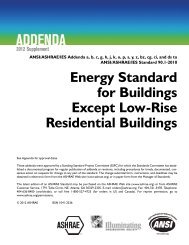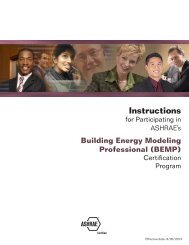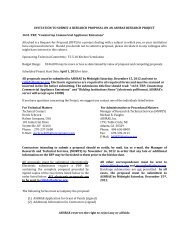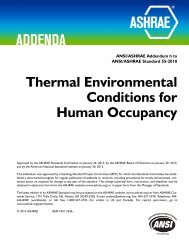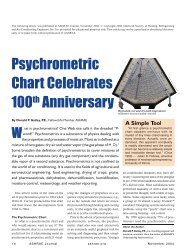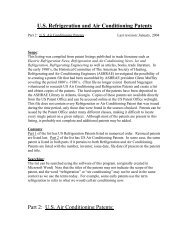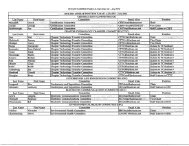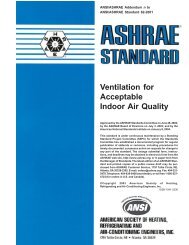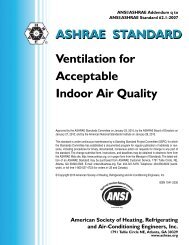ANSI/ASHRAE Standard 62.1-2007 ASHRAE STANDARD Ventilation
ANSI/ASHRAE Standard 62.1-2007 ASHRAE STANDARD Ventilation
ANSI/ASHRAE Standard 62.1-2007 ASHRAE STANDARD Ventilation
You also want an ePaper? Increase the reach of your titles
YUMPU automatically turns print PDFs into web optimized ePapers that Google loves.
(This foreword is not part of this standard. It is merely<br />
informative and does not contain requirements necessary<br />
for conformance to the standard. It has not been<br />
processed according to the <strong>ANSI</strong> requirements for a<br />
standard and may contain material that has not been<br />
subject to public review or a consensus process.<br />
Unresolved objectors on informative material are not<br />
offered the right to appeal at <strong>ASHRAE</strong> or <strong>ANSI</strong>.)<br />
FOREWORD<br />
This addendum modifies the IAQ procedure in Section 6.3<br />
and its description in Section 6.1.<br />
This addendum addresses compliance issues that may<br />
result from unclear wording or phrasing.<br />
This addendum makes a mass balance analysis a<br />
required part of the IAQ procedure.<br />
This addendum requires that performance of IAQ procedure<br />
designed systems be tested similar to the requirements<br />
to test VRP designed systems or that it be based<br />
on the tested performance of a design for a similar zone,<br />
with added requirements for determining whether a zone<br />
is similar.<br />
Note: In this addendum, changes to the current standard<br />
are indicated in the text by underlining (for additions)<br />
and strikethrough (for deletions) unless the instructions specifically<br />
mention some other means of indicating the<br />
changes.<br />
Addendum r to <strong>Standard</strong> <strong>62.1</strong>-<strong>2007</strong><br />
Note: Revise Section 6.1.2 as follows:<br />
6.1.2 IAQ Procedure. This is aThis performance-based<br />
design procedure (presented in Section 6.3), in which the<br />
building, outdoor air intake rates and other system design<br />
parameters are based on an analysis of contaminant sources,<br />
contaminant concentration targetlimits, and level of perceived<br />
indoor air acceptability targets, shall be permitted to be used<br />
for any zone or system. The IAQ Procedure allows credit to<br />
be taken for controls that remove contaminants (for example,<br />
air cleaning devices) or for other design techniques (for example,<br />
selection of materials with lower source strengths) that<br />
can be reliably demonstrated to result in indoor contaminant<br />
concentrations equal to or lower than those achieved using the<br />
<strong>Ventilation</strong> Rate Procedure. The IAQ Procedure may also be<br />
used where the design is intended to attain specific target contaminant<br />
concentrations or levels of acceptability of perceived<br />
indoor air quality.<br />
Note: Revise Section 6.3 as follows:<br />
6.3 Indoor Air Quality (IAQ) Procedure. The Indoor Air<br />
Quality (IAQ) Procedure is a performance-based design<br />
approach in which the building and its ventilation system are<br />
designed to maintain the concentrations of specific contaminants<br />
at or below certain limits identified during the building<br />
design and to achieve the design target level of perceived<br />
indoor air quality acceptability by building occupants and/or<br />
visitors. For the purposes of this procedure, acceptable per-<br />
ceived indoor air quality excludes dissatisfaction related to<br />
thermal comfort, noise and vibration, lighting, and psychological<br />
stressors.<br />
Breathing zone outdoor airflow (V bz ) and/or system<br />
outdoor air intake flow (V ot) shall be determined in accordance<br />
with Sections 6.3.1 thru 6.3.5.<br />
Note: Delete Section 6.3.1:<br />
6.3.1 Designs employing the IAQ Procedure shall comply<br />
with the requirements in the following sections.<br />
Note: Revise Section 6.3.1.1 as follows:<br />
6.3.1.1 Contaminant Sources. Contaminants or mixtures<br />
of concern for purposes of the design shall be identified. For<br />
each contaminant or mixture of concern, indoor sources<br />
(occupants and materials) and outdoor sources shall be<br />
identified, and the strength emission rate for each<br />
contaminant of concern from of each source shall be<br />
determined.<br />
Note: Appendix B lists information for some potential<br />
contaminants of concern.<br />
Note: Revise and Renumber Section 6.3.1.2 as follows:<br />
6.3.1.2 Contaminant Concentration. For each contaminant<br />
of concern, a target concentration limit and its corresponding<br />
exposure period and an appropriate reference to a<br />
cognizant authority shall be specified. (See Appendix B for<br />
some contaminant concentration guidelines.)<br />
Note: Appendix B includes concentration guidelines for<br />
some potential contaminants of concern.<br />
Note: Revise and Renumber Section 6.3.1.3 as follows:<br />
6.3.1.3 Perceived Indoor Air Quality. The criteria to<br />
achieve the design level of indoor air acceptability shall be<br />
specified in terms of the percentage of building occupants and/<br />
or visitors expressing satisfaction with perceived IAQ.<br />
Note: Delete existing Section 6.3.1.4 in its entirety:<br />
6.3.1.4 Design Approaches. Select one or a combination<br />
of the following design approaches to determine minimum<br />
space and system outdoor airflow rates and all other design<br />
parameters deemed relevant (e.g., air-cleaning efficiencies<br />
and supply airflow rates).<br />
a. Mass balance analysis. The steady-state equations in<br />
Appendix D, which describe the impact of air cleaning<br />
on outdoor air and recirculation rates, may be used as<br />
part of a mass balance analysis for ventilation systems<br />
serving a single space.<br />
b. Design approaches that have proved successful in similar<br />
buildings.<br />
c. Approaches validated by contaminant monitoring and<br />
subjective occupant evaluations in the completed building.<br />
An acceptable approach to subjective evaluation is<br />
presented in Appendix B, which may be used to validate<br />
2 <strong>ANSI</strong>/<strong>ASHRAE</strong> Addenda g, r, and t to <strong>ANSI</strong>/<strong>ASHRAE</strong> <strong>Standard</strong> <strong>62.1</strong>-<strong>2007</strong>



